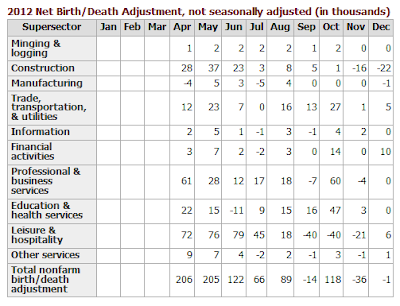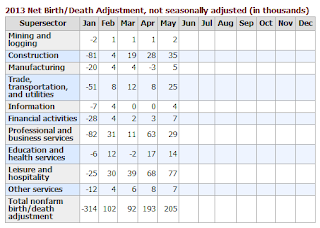Skip to comments.
Unemployment: Is the Obamacare Effect Played Out?
Townhall.com ^
| June 8, 2013
| Mike Shedlock
Posted on 06/08/2013 6:44:34 AM PDT by Kaslin
Initial Reaction
The establishment survey showed a gain of 175,000 a reasonably good but not spectacular print. The bright spot was involuntary part-time employment only rose by 26,000 so most of the jobs were (for a change) full-time jobs.
The civilian labor force rose by 420,000 for a change, enough to raise the unemployment rate 0.1 percentage points to 7.6%.
The Participation Rate rose 0.1 to 63.4%, just off the low of 63.3% dating back to 1979.
Obamacare Effect
Given there was not a huge jump in part-time employment this month, the bulk of the Obamacare effect of employers reducing hours from 32 to 25 (and hiring hundreds of thousands of new employees to make up the hours) may have mostly played out.
Nonetheless, expect lingering effects because any new business will be affected, as will businesses seeking to expand. See personal anecdotes at the end of this post for additional discussion.
May BLS Jobs Statistics at a Glance
- Payrolls +175,000 - Establishment Survey
- US Employment +319,000 - Household Survey
- US Unemployment +101,000 - Household Survey
- Involuntary Part-Time Work +26,000 - Household Survey
- Voluntary Part-Time Work -12,000 - Household Survey
- Baseline Unemployment Rate +0.1 - Household Survey
- U-6 unemployment -0.1 to 13.8% - Household Survey
- The Civilian Labor Force +420,000 - Household Survey
- Not in Labor Force -231,000 - Household Survey
- Participation Rate +0.1 at 63.4 - Household Survey
Revisions
The change in total nonfarm payroll employment for March was revised from +138,000 to +142,000, and the change for April was revised from +165,000 to +149,000. With these revisions, employment gains in March and April combined were 12,000 less than previously reported.
Recall that the unemployment rate varies in accordance with the Household Survey not the reported headline jobs number, and not in accordance with the weekly claims data.
Quick Notes About the Unemployment Rate
- In the last year, those "not" in the labor force rose by 1,741,000
- Over the course of the last year, the number of people employed rose by 1,596,000 (an average of 133,000 a month)
- In the last year the number of unemployed fell from 12,695,000 to 11,760,000 (a drop of 935,000)
- Long-Term unemployment (27 weeks and over) was 4,357,000 - a decline of 1,028,000 from a year ago
- Percentage of long-term unemployment is 37.3%. Once someone loses a job it is still very difficult to find another.
- 7,904,000 workers who are working part-time but want full-time work. A year ago there were 8,116,000. There has been little improvement in a year. This is a volatile series.
May 2013 Jobs Report
Please consider the Bureau of Labor Statistics (BLS) April 2013 Employment Report.
Total nonfarm payroll employment increased by 175,000 in May, and the unemployment rate was essentially unchanged at 7.6 percent, the U.S. Bureau of Labor Statistics reported today. Employment rose in professional and business services, food services and drinking places, and retail trade.
Click on Any Chart in this Report to See a Sharper Image
Unemployment Rate - Seasonally Adjusted

Month to Month Changes

click on chart for sharper image
Hours and Wages
Private average weekly hours were flat at 34.4 hours. Average hourly earnings of all private workers rose $0.01 to $23.89. Average hourly earnings of private-sector production and nonsupervisory employees was also up $0.01 to $20.08.
Real wages have been declining. Add in increases in state taxes and the average Joe has been hammered pretty badly. For 2013, one needs to factor in the increase in payroll taxes for Social Security.
For further discussion of income distribution, please see What's "Really" Behind Gross Inequalities In Income Distribution?
BLS Birth-Death Model Black Box
The BLS Birth/Death Model is an estimation by the BLS as to how many jobs the economy created that were not picked up in the payroll survey.
The Birth-Death numbers are not seasonally adjusted, while the reported headline number is. In the black box the BLS combines the two, coming up with a total.
The Birth Death number influences the overall totals, but the math is not as simple as it appears. Moreover, the effect is nowhere near as big as it might logically appear at first glance.
Do not add or subtract the Birth-Death numbers from the reported headline totals. It does not work that way.
Birth/Death assumptions are supposedly made according to estimates of where the BLS thinks we are in the economic cycle. Theory is one thing. Practice is clearly another as noted by numerous recent revisions.
Birth Death Model Adjustments For 2012

Birth Death Model Adjustments For 2013

Birth-Death Notes
Once again: Do NOT subtract the Birth-Death number from the reported headline number. That approach is statistically invalid.
In general, analysts attribute much more to birth-death numbers than they should. Except at economic turns, BLS Birth/Death errors are reasonably small.
For a discussion of how little birth-death numbers affect actual monthly reporting, please see BLS Birth/Death Model Yet Again.
Table 15 BLS Alternate Measures of Unemployment

click on chart for sharper image
Table A-15 is where one can find a better approximation of what the unemployment rate really is.
Notice I said "better" approximation not to be confused with "good" approximation.
The official unemployment rate is 7.6%. However, if you start counting all the people who want a job but gave up, all the people with part-time jobs that want a full-time job, all the people who dropped off the unemployment rolls because their unemployment benefits ran out, etc., you get a closer picture of what the unemployment rate is. That number is in the last row labeled U-6.
U-6 is much higher at 13.8%. Both numbers would be way higher still, were it not for millions dropping out of the labor force over the past few years.
Labor Force Factors
- Discouraged workers stop looking for jobs
- People retire because they cannot find jobs
- People go back to school hoping it will improve their chances of getting a job
- People stay in school longer because they cannot find a job
Were it not for people dropping out of the labor force, the unemployment rate would be over 10%. In addition, there are 7,904,000 workers who are working part-time but want full-time work. A year ago there were 7,618,000. There has been no improvement in a year. This is a volatile series.
Grossly Distorted Statistics
Digging under the surface, much of the drop in the unemployment rate over the past two years is nothing but a statistical mirage coupled with a massive increase in part-time jobs starting in October 2012 as a result of Obamacare legislation.
Personal Anecdote
As a personal anecdote, I was in the Traverse City, Michigan area this past week, a very nice town with nice shops in the downtown area. I asked one of the clerks about the number of hours she was working and they were reduced from 32 to 25, same as with numerous other shops on the same street. She did not understand why. She does now.
I have asked waiters in many cities similar questions over the past few months and have received many similar answers.
Multiply this scene by hundreds or thousands of shops in thousands of towns and the reduction from 32 to 25 hours coupled with additional hiring to make up the needed hours played a significant role in distortion of normal hiring patterns and unemployment statistics.
TOPICS: Business/Economy; Culture/Society; Editorial
KEYWORDS: abortion; benghazi; carbontax; deathpanels; economynews; elections; fastandfurious; government; governmentspending; house; impeachnow; irs; jobs; mikeshedlock; obama; obamacare; obamarecession; partisanmediashill; partisanmediashills; republicans; senate; zerocare
1
posted on
06/08/2013 6:44:34 AM PDT
by
Kaslin
To: Kaslin
The Obamacare effect has not even been felt yet as it hasn’t even really started yet. Wait till 2014.
2
posted on
06/08/2013 6:59:03 AM PDT
by
frogjerk
(We are conservatives. Not libertarians, not "fiscal conservatives", not moderates)
To: Kaslin
3
posted on
06/08/2013 7:28:40 AM PDT
by
KeyLargo
To: frogjerk
I’m seeing stories about people being downgraded to “29ers” all over the media. So I think it has started.
4
posted on
06/08/2013 7:30:00 AM PDT
by
nascarnation
(Baraq's economic policy: trickle up poverty)
To: Kaslin

how many people between 18 and 65 are working vs how many aren't???
5
posted on
06/08/2013 7:48:20 AM PDT
by
Chode
(Stand UP and Be Counted, or line up and be numbered - *DTOM* -ww- NO Pity for the LAZY)
To: frogjerk
You’re right. The full effect won’t be seen or even known until the fines and penalties kick in. What we’ve seen thus far is just battening down the hatches, not drastic action after the storm has hit.
6
posted on
06/08/2013 8:13:35 AM PDT
by
tbw2
To: Kaslin
Um, no.
One only has to look at the participation rate.
It’s not about “part time” jobs, it’s about NO jobs.
ObamaCare is just dividing the table scraps left over among other things for now.
Wait until people have to start cutting checks at the end of the year. Just like if it wasn’t for withholding, we would have had a tax revolt a long time ago.
7
posted on
06/08/2013 8:47:32 AM PDT
by
headstamp 2
(What would Scooby do?)
To: Kaslin
How does the government detect that, a discouraged worker who left the work-force, has re-entered the work-force?
8
posted on
06/08/2013 9:55:09 AM PDT
by
adorno
(Y)
To: Kaslin
Conservatives need a simple, clear and honest reassessment of what's causing income inequality.
1. The Gini coefficient was created for a sole purpose of selling fascism.
2. Measuring household income is a statistical trick. It's a lie because there isn't a consistent and objective measurement of ‘household’.
3. Illegal immigration has moved many low skill, low education Mexicans into the American economy. That demographic isn't very pro-education. Those factors bring down income.
4. 80% of the poor, per the US Census, are single moms. That demographic has exploded.
Those four items can armor us up against the ‘income inequality’ attack. Furthermore, government has expanded at an incredible rate without affecting ‘income inequality’. So that's not the solution.
If we can take out vote fraud and Obama’s use of the governmental power to castrate his opponents can undo the current fiasco. We need to hold the Congress for a generation and regain the presidency at least 12 of those 20 years.
9
posted on
06/08/2013 10:22:52 AM PDT
by
1010RD
(First, Do No Harm)
Disclaimer:
Opinions posted on Free Republic are those of the individual
posters and do not necessarily represent the opinion of Free Republic or its
management. All materials posted herein are protected by copyright law and the
exemption for fair use of copyrighted works.
FreeRepublic.com is powered by software copyright 2000-2008 John Robinson





 how many people between 18 and 65 are working vs how many aren't???
how many people between 18 and 65 are working vs how many aren't???